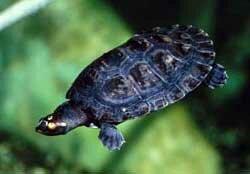 Arrau Turtle Arrau Turtle
scientific name
Podocnemis expansa
size
Size: carapace to 3 ft
Weight: up to 100 lbs " males smaller
characteristics
Body: oval, flattened carapace widest point behind center " carapace scutes usually lack ridges or raised annuli rings " one scale between eyes with groove " plastron, bridge and undersides or marginals yellow, neck grey on top, yellow underneath
Head: broad head with protruding snout, squared off upper jaw carapace olive to dark gray, brown " head grey-brown with yellow markings " jaws tan " juveniles and males have yellow spots on heads
Feet: limbs gray " 5 claws on front limbs, 4 on back
Behaviour: fast in dry season
reproduction/life span
Mate. in water
Breeding: nest on low sandy beaches and sandbars in dry season " suitable sites arear, as many as 500 females may congregate at one site " dig body pit 32-40 in deep, flask-shaped nest up to 32 in deep excavated in bottom of pit " pits and nests may be shared
Gestation. female basks 6+ hr per day to hasten egg development " after several weeks go back to water and emerge in groups at night to explore beach for a few nights until lay eggs together " lays 63-136 eggs per nest " eggs spherical 1-2 in " may lay more than 1 clutch per season
Incubation: about 50 days " hatchlings about 1.5 in
diet
Wild: herbivorous " fruits, flowers, roots, soft vegetation of aquatic plants " will eat meat in captivity
habitat/range
Habitat: : large rivers & tributaries, adjacent lagoons and forest ponds
Range: Caribbean drainages of Guyana & Venezuela, upper Amazon tributaries in Bolivia, Peru, Colombia, Venezuela & Brazil, Trinidad
status
IUCN endangered " FWS endangered
other
called Giant South American River Turtle " tataruga in Brazil, charapa in Peru, arrau in Venezuela
note
overexploited for meat, oil & eggs " threatened by habitat alteration and destruction " predators include jaguars & crocodiles
oregon zoo exhibit
Amazon
back to top
|


